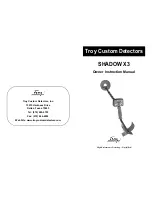
38
Departement of international trade:
RT-ST this setting is characterized by the fact that when the ST tone is
generated the RT tone drops out.
ST-P {Short Tone Polyphonic}.
Ability to give both a low tone and high
tones at the same time. For example, when giving a signal from the
small flat iron targets (beer bottle caps, small pieces of sheet metal, etc.)
Num. of tones [2, 3, 4, 5]
. Sets the number of tones for audio identifica-
tion.
LT Boundary (The boundary for the low tone (iron)).
This option allows
the user to set the boundary for the low tone.
In areas of mineralized soil
as well as areas with small iron nails, targets such as small shallow gold
and other low VDI targets will indicate a negative VDI. Usually these
give a signal between the medium-large iron VDI range and foil VDI
range. Medium wrought iron targets such as wrought iron nails will have
a VDI vector of -45 to -40. Foil will have a VDI vector of 0 or close to
this. Therefore those targets with a VDI from 0 to -35 are considered
“suspicious” and subject to research when looking for small gold jewelry,
small medieval daggers or coins within debris. When setting the
boundary of the LT remember these facts in order to not miss valuable
targets when searching
under these conditions. So, if we receive a good
tone, even if the hodo-graph indicates a loop, with 95% confidence we
can say that this is possibly a good non ferrous target. Together with
the separation rate of the MM search mode this setting will increase your
chances of not missing a non ferrous target mixed in the iron. Try to set
the border for these lower tones appropriately. If you perform a search in
places where the medium/large iron can be interesting (Arrowheads,
knives, medieval items etc.) you can move the nonferrous tone to the
sector border where the majority of large iron indicates at -45 (-50
possible maximum).
Volume WS (Volume of weak signals) [1..15].
Adjusting this parameter allows you to change the volume of the ST
from weak signals from small or deep targets. Smaller values of this
parameter can control the level of the volume signal for a wider range of
target depths. However, at very low settings signals from small or
extremely deep objects can be too quiet. Very high settings will reduce
the differential volume level between deep and shallow targets.
Therefore, the value of this parameter is selected experimentally, to
individual user preferences.
















































